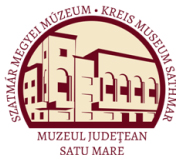Szőcs Péter Levente (szerk.): Arhitectura ecleziastică din Satu Mare (Satu Mare, 2008)
Săcăşeni - Érszakácsi
provenienţa numelui localităţii de la bucătarul regelui Matia, care a fost exilat în sat după ce a furat şi a fost prins asupra faptului. (TSz). Érszakácsi. Református templom A község jelenlegi temploma a 18. század második felében épülhetett, tornya és mellékhajója viszont a 19. században. A hajó és a torony külső megjelenése egységes, lizénák és hangsúlyos párkányok tagolják. A toronysisak szép formájú, kettős hagyma-idomból kombinált. A templom kazettás mennyezetét 1991-ben lemázolták, viszont eredeti pompájukban láthatók még a karzatok, a padok mellvédjei, valamint a szószékkorona és a papi szék háttámlája. A festett népi berendezésen, amely 1760 körül készülhetett, a különböző virágmotívumokból szerkesztett minták meleg színekben, az okker, a vörös és a zöld különböző árnyalataiban pompáznak. A templomban található egy használaton kívüli gótikus harang is. Harangjai 1851-ből és 1956-ból származnak. Érdekes hagyomány, hogy a helyiek a falu nevét onnan eredeztetik, hogy Mátyás lopáson ért főszakácsát ide száműzte, s kénytelen volt itt letelepedni. (TSz). Săcăşeni. The Calvinist Church The present church was probably built in the second half of the 18th century; the tower and the side-nave were made in the 19th century. The aspect of the church is a unit; cornices and lesenas divide the outer facade. The steeple of the tower has two parts in the shape of an onion bulb. The ceiling with cassettes was repainted in 1991, but the original painting is still visible at the level of the choir, on the benches, on the roof of the pulpit, and on the back of the priest’s chair. The paintings on the furniture were made in popular style around 1760, combining warm colors, ochre, red and green, with great artistry. Beside the bells made in 1851 and 1956, there is also a bell dating from the Gothic period, but it isn’t used. Local legends say the name of the locality comes from the chef of King Mathias, who was exiled to the village after stealing and being caught in the act. (TSz). > — ■ > mi ■■ < <<m ■ mm I 135
